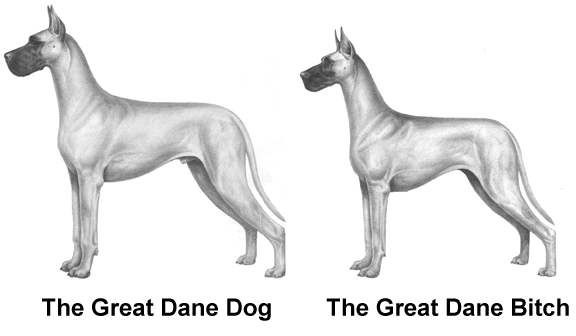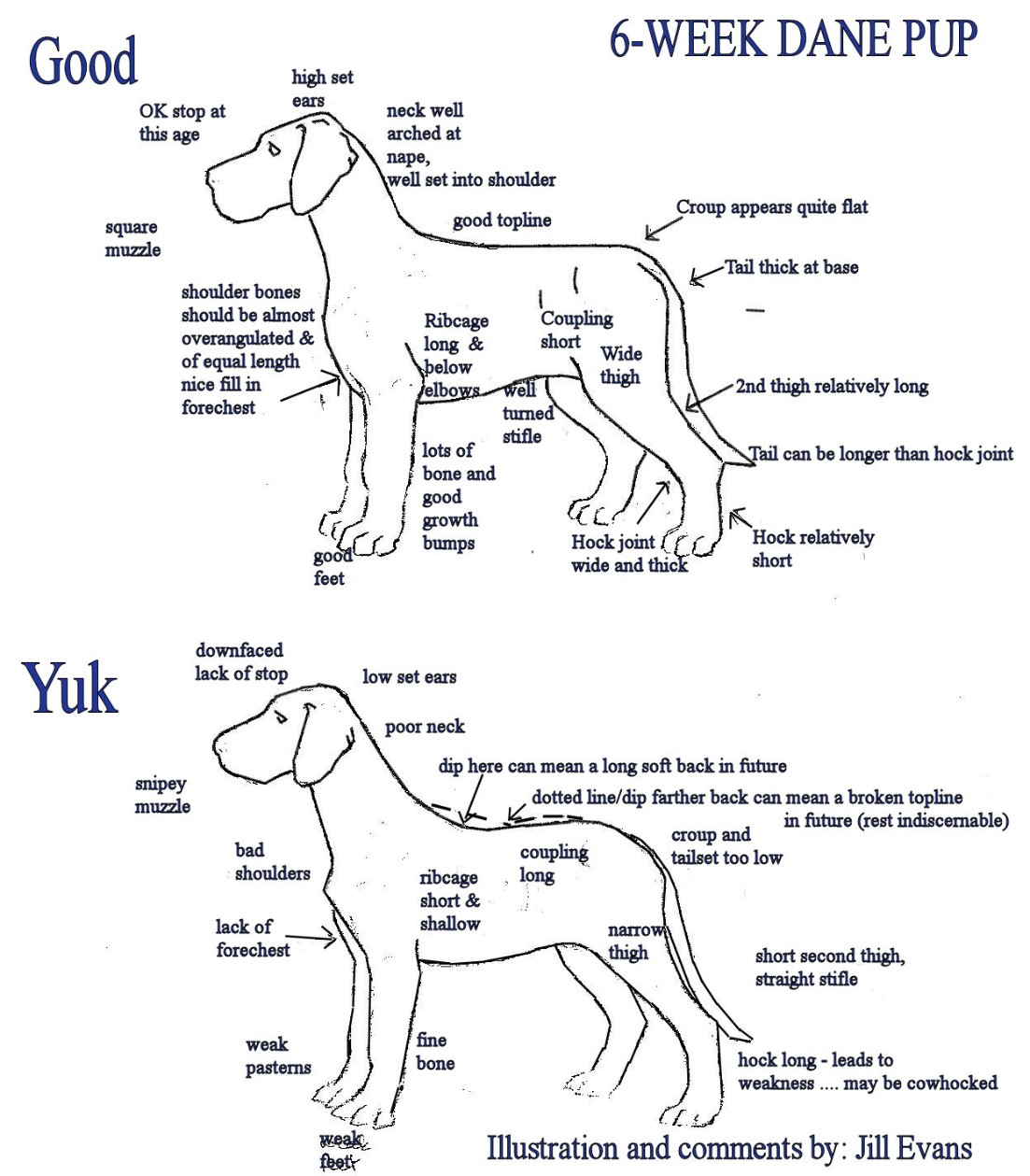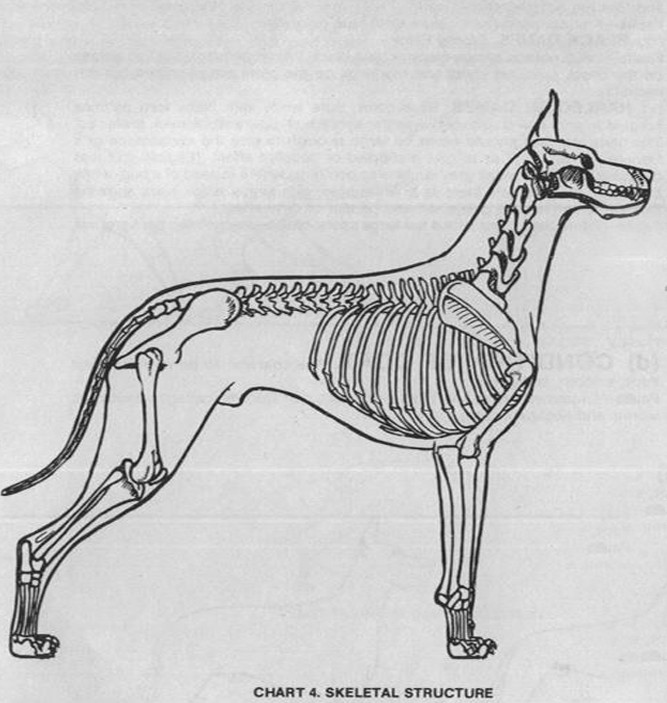Great Dane
A "gentle giant," the Great Dane is nothing short of majestic. Sometimes referred to as the "king of dogs," this extremely large dog breed is known for being strong yet elegant, with a friendly, energetic personality. Striking in the show ring, this breed is also popular as a family pet. Coat colors can be brindle, fawn, blue, black, harlequin and mantle.

A Look Back
Historians
claim that there are drawings of dogs that resemble the Great Dane on
Egyptian monuments from roughly 3000 B.C. The earliest written
description of a dog resembling the breed can be found in Chinese
literature of 1121 B.C. The origins of the Great Dane as we know it
today can be traced to the Irish Wolfhound with mixture of old
English Mastiff. The breed was originally developed by the Germans to
hunt boar, a ferocious animal. When no longer used for hunting, the
breed changed to one of a companion and estate guard dog.
Right Breed for You?
Great
Danes have gentle and loving dispositions, making them excellent
family companions, but as with all dogs, they should be supervised
around young children. Daily exercise is necessary, but their short
coats require minimal grooming.
Working Group; AKC recognized in 1887.
Minimum height of 30 inches tall at the shoulder for males and 28 inches tall for females.
Boar hunter; estate guard dog.
Great Dane Breed Standard
Working Group
General Appearance
The
Great Dane combines, in its regal appearance, dignity, strength and
elegance with great size and a powerful, well-formed, smoothly
muscled body. It is one of the giant working breeds, but is unique in
that its general conformation must be so well balanced that it never
appears clumsy, and shall move with a long reach and powerful drive.
It is always a unit-the Apollo of dogs. A Great Dane must be
spirited, courageous, never timid; always friendly and dependable.
This physical and mental combination is the characteristic which
gives the Great Dane the majesty possessed by no other breed. It is
particularly true of this breed that there is an impression of great
masculinity in dogs, as compared to an impression of femininity in
bitches. Lack of true Dane breed type, as defined in this standard,
is a serious fault.
Size, Proportion, Substance
The
male should appear more massive throughout than the bitch, with
larger frame and heavier bone. In the ratio between length and
height, the Great Dane should be square. In bitches, a somewhat
longer body is permissible, providing she is well proportioned to her
height. Coarseness or lack of substance are equally undesirable. The
male shall not be less than 30 inches at the shoulders, but it is
preferable that he be 32 inches or more, providing he is well
proportioned to his height. The female shall not be less than 28
inches at the shoulders, but it is preferable that she be 30 inches
or more, providing she is well proportioned to her height. Danes
under minimum height must be disqualified.
Head
The
head shall be rectangular, long, distinguished, expressive, finely
chiseled, especially below the eyes. Seen from the side, the Dane’s
forehead must be sharply set off from the bridge of the nose, (a
strongly pronounced stop). The plane of the skull and the plane of
the muzzle must be straight and parallel to one another. The skull
plane under and to the inner point of the eye must slope without any
bony protuberance in a smooth line to a full square jaw with a deep
muzzle (fluttering lips are undesirable). The masculinity of the male
is very pronounced in structural appearance of the head. The bitch’s
head is more delicately formed. Seen from the top, the skull should
have parallel sides and the bridge of the nose should be as broad as
possible. The cheek muscles should not be prominent. The length from
the tip of the nose to the center of the stop should be equal to the
length from the center of the stop to the rear of the slightly
developed occiput. The head should be angular from all sides and
should have flat planes with dimensions in proportion to the size of
the Dane. Whiskers may be trimmed or left natural. Eyes shall
be medium size, deep set, and dark, with a lively intelligent
expression. The eyelids are almond-shaped and relatively tight, with
well developed brows. Haws and mongolian eyes are serious faults. In
harlequins, the eyes should be dark; light colored eyes, eyes of
different colors and walleyes are permitted but not
desirable. Ears shall
be high set, medium in size and of moderate thickness, folded forward
close to the cheek. The top line of the folded ear should be level
with the skull. If cropped, the ear length is in proportion to the
size of the head and the ears are carried uniformly erect.Nose shall
be black, except in the blue Dane, where it is a dark blue-black. A
black spotted nose is permitted on the harlequin; a pink colored nose
is not desirable. A split nose is a disqualification. Teeth shall
be strong, well developed, clean and with full dentition. The
incisors of the lower jaw touch very lightly the bottoms of the inner
surface of the upper incisors (scissors bite). An undershot jaw is a
very serious fault. Overshot or wry bites are serious faults. Even
bites, misaligned or crowded incisors are minor faults.
Neck, Topline, Body
The
neck shall be firm, high set, well arched, long and muscular. From
the nape, it should gradually broaden and flow smoothly into the
withers. The neck underline should be clean. Withers shall slope
smoothly into a short level back with a broad loin. The chest shall
be broad, deep and well muscled. The forechest should be well
developed without a pronounced sternum. The brisket extends to the
elbow, with well sprung ribs. The body underline should be tightly
muscled with a well-defined tuck-up.
The croup should be broad and very slightly sloping. The tail should be set high and smoothly into the croup, but not quite level with the back, a continuation of the spine. The tail should be broad at the base, tapering uniformly down to the hock joint. At rest, the tail should fall straight. When excited or running, it may curve slightly, but never above the level of the back. A ring or hooked tail is a serious fault. A docked tail is a disqualification.
Forequarters
The
forequarters, viewed from the side, shall be strong and muscular. The
shoulder blade must be strong and sloping, forming, as near as
possible, a right angle in its articulation with the upper arm. A
line from the upper tip of the shoulder to the back of the elbow
joint should be perpendicular. The ligaments and muscles holding the
shoulder blade to the rib cage must be well developed, firm and
securely attached to prevent loose shoulders. The shoulder blade and
the upper arm should be the same length. The elbow should be one-half
the distance from the withers to the ground. The strong pasterns
should slope slightly. The feet should be round and compact with
well-arched toes, neither toeing in, toeing out, nor rolling to the
inside or outside. The nails should be short, strong and as dark as
possible, except that they may be lighter in harlequins. Dewclaws may
or may not be removed.
Hindquarters
The
hindquarters shall be strong, broad, muscular and well angulated,
with well let down hocks. Seen from the rear, the hock joints appear
to be perfectly straight, turned neither toward the inside nor toward
the outside. The rear feet should be round and compact, with
well-arched toes, neither toeing in nor out. The nails should be
short, strong and as dark as possible, except they may be lighter in
harlequins. Wolf claws are a serious fault.
Coat
The
coat shall be short, thick and clean with a smooth glossy appearance.
Color, Markings and Patterns
Brindle--The
base color shall be yellow gold and always brindled with strong black
cross stripes in a chevron pattern. A black mask is preferred. Black
should appear on the eye rims and eyebrows, and may appear on the
ears and tail tip. The more intensive the base color and the more
distinct and even the brindling, the more preferred will be the
color. Too much or too little brindling are equally undesirable.
White markings at the chest and toes, black-fronted, dirty colored
brindles are not desirable.
Fawn--The color shall be yellow gold with a black mask. Black should appear on the eye rims and eyebrows, and may appear on the ears and tail tip. The deep yellow gold must always be given the preference. White markings at the chest and toes, black-fronted dirty colored fawns are not desirable.
Blue--The color shall be a pure steel blue. White markings at the chest and toes are not desirable.
Black--The color shall be a glossy black. White markings at the chest and toes are not desirable.
Harlequin--Base color shall be pure white with black torn patches irregularly and well distributed over the entire body; a pure white neck is preferred. The black patches should never be large enough to give the appearance of a blanket, nor so small as to give a stippled or dappled effect. Eligible, but less desirable, are a few small gray patches, or a white base with single black hairs showing through, which tend to give a salt and pepper or dirty effect.
Mantle--The color shall be black and white with a solid black blanket extending over the body; black skull with white muzzle; white blaze is optional; whole white collar is preferred; a white chest; white on part or whole of forelegs and hind legs; white tipped black tail. A small white marking in the blanket is acceptable, as is a break in the white collar.
Any variance in color or markings as described above shall be faulted to the extent of the deviation. Any Great Dane which does not fall within the above color classifications must be disqualified.
Gait
The
gait denotes strength and power with long, easy strides resulting in
no tossing, rolling or bouncing of the topline or body. The backline
shall appear level and parallel to the ground. The long reach should
strike the ground below the nose while the head is carried forward.
The powerful rear drive should be balanced to the reach. As speed
increases, there is a natural tendency for the legs to converge
toward the centerline of balance beneath the body. There should be no
twisting in or out at the elbow or hock joints.
Temperament
The
Great Dane must be spirited, courageous, always friendly and
dependable, and never timid or aggressive.
Disqualifications
Danes
under minimum height.
Split nose. Docked Tail.
Any color other
than those described under "Color, Markings and Patterns."
Picking A Puppy Diagram


















